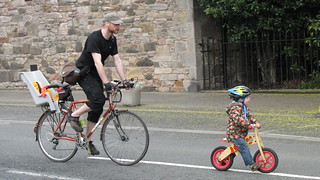Per spokes newsletter - some notes to consider both HST's and Class 158's (West Highland Line)
Photos/videos of bikes smashing around/not fitting on Voyagers welcomed, remembering that a day return Cross Country Only us available all day from around £11 and at 55 minutes not much slower than via Falkirk High.
The work being done on HST's is minimal - and thus there is currently no budget for any other work - I'll explain this below but before considering this let's review what the real position is now and will be in 2018
Now - the current morning HST Inverness to Kings Cross is reported to carry up to 30 bikes - mostly loaded in a managed way in Inverness, with 8-10 minutes at Waverley to unload before the train heads South. The current 170 services can accommodate up to 16 bikes per 3-car unit when the service is not busy, within the criteria set by Scotrail's safety case (ROGS), and un-officially treating one of the wheechair spaces as NOT inviolate for ANY other use.
2018 - HST's will run fast services, EVERY HOUR, during the day (against current less structured timetable) with 170's running stopping services to cover catchment areas (eg Kingussie-Inverness, Inverurie-Aberdeen-Stonehaven, Arbroath-Dundee-(Perth?) etc)
But let's really open this debate to delivery of a solution which works across ALL the resources that can support cycle tourism, and integrated transport across ALL of Scotland.
Work that I've been involved with has secured Scottish Citylink & Stagecoach Express conditions to carry cycles on their coaches.
1) Scottish Citylink - delivers to Argyll, Skye, Ullapool (for Stornoway) Scrabster/Gills Bay (for Orkney and John o Groats), as well as parallel capacity (and alternative times) for Scotrail routes. Already been working on this - need to run a pilot (Argyll to shake down). Clause 56 Conditions of carriages - cycles are carried subject to space being available and the cycles in a bag or case. Need to deliver the facility to secure a space by reservation - using the current system to reserve wheelchair journeys, and book the seats for 'open tickets' and Concession Card holders - currently 50p per transaction.
2) Stagecoach - Carry bikes on their Express coach services, and some bus services. 40+ bikes/week on X7 Perth-Aberdeen. up to 10 bikes on 50/65 seat coaches when kids go to MTB or BMX trails in Highlands. Clause 7 (East of Scotland - & similar for others) To work with Stagecoach on pilot schemes to carry bikes on some bus services which carry few or no passengers - eg balancing journeys to start commuter trips - driving empty bus to Pitlochry/Aberfeldy/Crieff in morning and same in reverse at night (ideal way to have a day's ride in countryside?) Already delivering with West Coast Motors 448 service (Hitrans contract) plus all Western Isles Council supported services have cycle carriage as a condition of contract
3) Serco - Highland Sleeper - blocking access to empty seats and van space through lack of proper promotion and user unfriendly bookings system - Scottish Government is paying for this service but missing out on the potential it offers, especially for the West Highlands and Western Isles. A further massive missed opportunity to deliver Oban connection for morning ferries from Edinburgh which can be sorted by not having the Fort William train held for 1 hour at Waverley between 03.50 and 04.50. Would propose a cross-platform interchange at Dumbarton Central or a connection at Dalmuir (Platform 3 to Platform 1) to deliver this. I regularly use this service as a way to get to make early and late connections at Preston and Crewe not available through other services but despite the train running with most (or all) seats (and bike spaces) empty actually getting to travel on it is a challenge, with major deterrent factors - not least the fact that you cannot officially board the Southbound train when it stops at Glasgow Queen Street (00.15) but you can (unofficially) get off the Northbound service (05.48 - or earlier)
4) Class 158 'scenic train' refurbishments for West Highland - from 6 spaces per unit (Class 156) to 2 spaces (current Class 158). Several options 1) As Class 156 only has one accessible toilet per 2 carriages, remove the cramped second toilet on Class 158 and create generous vestibule space which can accommodate 4-6 bikes (8 may be possible) 2) there are 4 seat/luggage rack bays per carriage (8 per unit) where the doors open over the outside, and there are no windows - so no place for scenic seating each space can accommodate 1 bike/luggage stack. Personal thought do both!
Finally the HST's
56 Power cars (2 spare) on transfer from GWR will have minimal work - remove ATO system (used only on GWR) and they come with 3 bike rack in the space which could accommodate a 5-6 bike rack (as it does in Coach A van space) - Budget to fit new frames similar to cycle storage installation at 2 Parkside Edinburgh (Homebikepark project)
130-140 Mk 3 carriages to fit CET tank and system will be one toilet only at one end of carriage (and one will be accessible toilet) To fit sliding doors the existing toilets and luggage racks at the ends of each carriage will need to be removed. The unused toilet and panelling etc will be put back - one will have the end removed to provide bike stowage. I would press to have the space reconfigured to the design already used by Chiltern, which removed both the toilet AND luggage rack to create a larger vestibule space which can have tip-up or perch seating and a securing system for bike stowage. This will have a major benefit for reducing dwell times at stations getting passengers on & off the train quickly by having the surge space at the door, and it also provides crush space options for when the HST's are running on services with high commuter demand (eg the Inverkeithing/Kirkcaldy-Edinburgh stage of an early Aberdeen-Edinburgh service) The design exists - so it could be budgetted for as an alternative to putting back the original panels.
A major safety concern is the indication of cycle stowage design, which could well deliver a condition outside the envelope set by the HSC Manual Handling Regulations, for the weight and position of the load being lifted - any passnger injuries due to thus being outside the HSC regulations could have serious implications. There is NO NEED to lift the full weight of a bike to hang it vertically, as this system requires. The system does not secure the bike - even with the messy tangle of straps provided, as it fails to use the weight of the bike to locate it and keep it stable. A design which does deliver this has been used on rail vehicles since 1989 and should be considered. The hanging system shown (used on Voyagers) has been bent (not strong enough?) and its failure to secure bikes is apparent from the damage to the internal panelling on the Cross Country units (Coach D)
Even at 100+Kg and reasonably strong (1000 watts peak output on cycle trainer), with the leverage/reach of a 2.0m frame, I was unable to lift a 19Kg bike on to the hook on a moving Voyager leaving Glasgow (and on the return trip from Edinburgh) Imagine that for a small 60-70Kg person with low upper body strength, and you'll see how bad and potentially dangerous this design is.
https://www.flickr.com/photos/h52/33937389430/in/datetaken/ Mounting plate - bent Stop plate - bent (some have totally failed and bent right back)
https://www.flickr.com/photos/h52/34163419022/in/datetaken/ Stop plate - bent and almost failing to stop rotation
https://www.flickr.com/photos/h52/34278714535/in/datetaken/ Mounting plate - bent
Happy to discuss
Dave Holladay
07 710 535 404

 posts
posts
